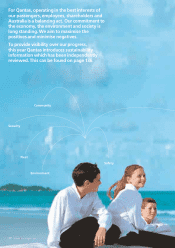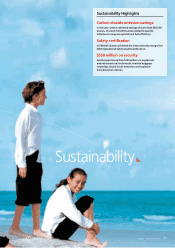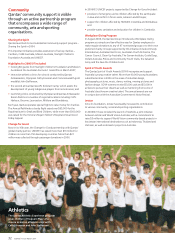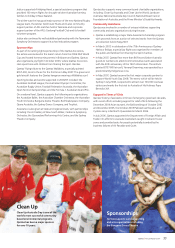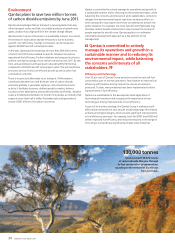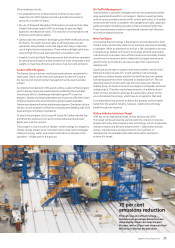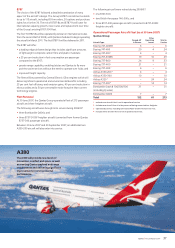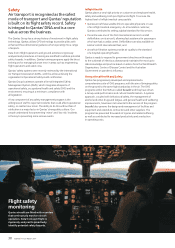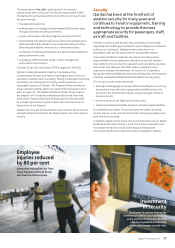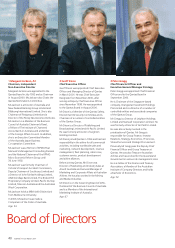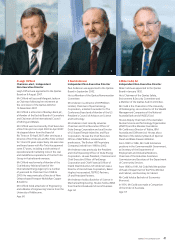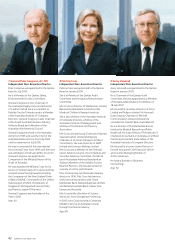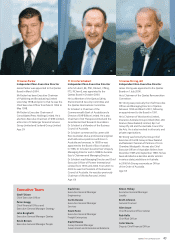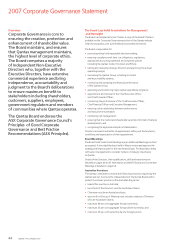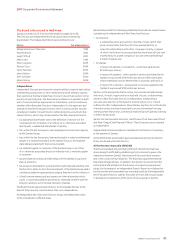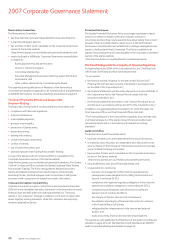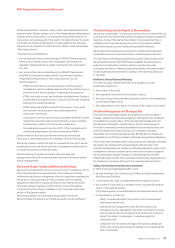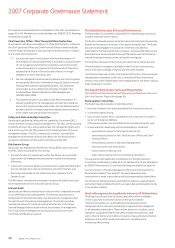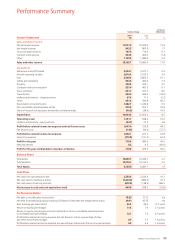Qantas 2007 Annual Report Download - page 41
Download and view the complete annual report
Please find page 41 of the 2007 Qantas annual report below. You can navigate through the pages in the report by either clicking on the pages listed below, or by using the keyword search tool below to find specific information within the annual report.
39Qantas |Annual Report 2007
The key measure of be safe!, and its goal of ‘no injuries to
anyone at any time’ is the Lost Time Injury Frequency Rate (LTIFR).
The Qantas Group has reduced this rate by 80 per cent over the last
five years through:
•management leadership;
•implementation of strategic and operational OHS business plans
through a hierarchy of safety committees;
•regular performance reporting triggering revision of actions;
•recommitting individuals to safe work practices by dedicating one
week annually (Safety Week) to overt and public safety activities,
talks and presentations, news articles, e-mails and posters;
•recognition of individual employees who demonstrate exceptional
safety performance; and
•including an LTIFR reduction target in senior management
performance remuneration.
A further 20 per cent reduction in LTIFR is targeted in 2007/08.
Qantas is leading the aviation industry in Australia with its
comprehensive Alcohol and Other Drugs Program and its focus on
education, treatment and counselling. Testing is undertaken following
an incident, pre-employment for safety sensitive positions or on
reasonable suspicion of a breach. The Program will be extended to
adopt a random testing regime once government regulations are in
place to support it. The Qantas Alcohol and Other Drugs Program
has played a role in reducing workplace accidents and improving
productivity. Positive behavioural change has been demonstrated
by a steady improvement in post-incident test outcomes since the
introduction of the Program.
Qantas looks forward to the Australian Government’s introduction of
mandatory/random testing for all safety sensitive roles in the aviation
industry.
Security
Qantas has been at the forefront of
aviation security for many years and
continues to invest in equipment, training
and technology to provide the most
appropriate security for passengers, staff,
aircraft and facilities.
Aviation security is a very dynamic area, and Qantas is continually
upgrading and modifying procedures to meet changing circumstances
as they arise. In doing so, Qantas provides protection to our
passengers, staff, aircraft and facilities in a sustainable manner.
Governments and their respective security services take primary
responsibility for threat assessment and national security. Qantas is
responsible for the security of its operations and maintains a proactive
and constructive dialogue with these bodies, enabling prompt
response to changes in threat levels. In the spirit of co-operation,
Qantas also makes available its experience and expertise to the process
of setting sustainable global and national aviation security policy.
The Group’s security measures include:
•passenger and baggage screening facilities including the use of x-ray
and explosive trace detection equipment and additional security
services for the monitoring of liquids, aerosols and gels carried on
board an aircraft;
•reinforced doors at the flight deck entrance; and
•closed circuit television facilities at airports and other Qantas facilities.
To complete this program, Group employees are subject to regular
security checks, as are contractors and other third party suppliers who
work within secure areas.
In addition, Qantas works closely with aircraft manufacturers to design
and build aircraft with security in mind. This will assist manufacturers
incorporate the latest in security technology at manufacture,
thus enhancing the suite of security measures available to Qantas.
Employee
injuries reduced
by 80 per cent
Qantas has reduced its Lost Time
Injury Frequency Rate by 80 per
cent over the last five years.
Investment
in security
The Qantas Group has been at the
forefront of aviation security for many
years and has continued to develop
effective capabilities to identify,
assess and manage security risks.



